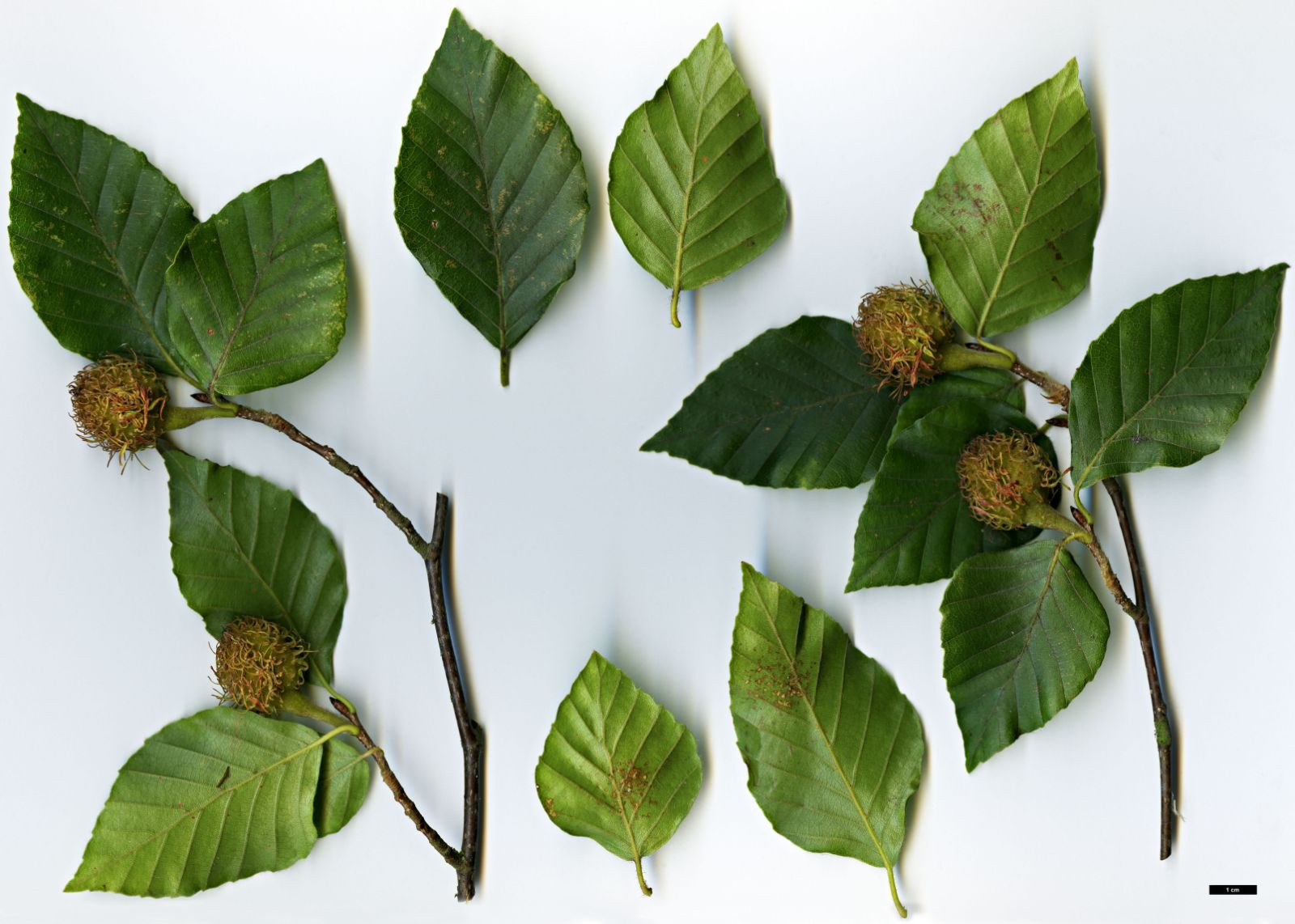Fagus crenata
Sponsor
Kindly sponsored by
a member of the International Dendrology Society
Credits
John Grimshaw & Tom Christian (2021)
Recommended citation
Grimshaw, J. & Christian, T. (2021), 'Fagus crenata' from the website Trees and Shrubs Online (treesandshrubsonline.
Genus
Common Names
- Japanese Beech
- Buna
Synonyms
- Fagus sieboldii Endl.
- Fagus sieboldii A.DC.
- Fagus sylvatica var. sieboldii (A.DC.) Maxim.
- Fagus sylvatica var. asiatica A.DC., in part
Tree to 30 m, 1 m dbh. Bark greyish. Young shoots sparsely long-pubescent at first, becoming glabrous. Leaves 5–8 × 3–5 cm, mid-green above, pale green below, long-pubescent when young, especially on margins and veins below, becoming glabrous, ovate to rhombic-ovate, broadest below the middle, margins undulate, with small or no teeth, base cuneate to rounded or shallowly cordate, apex short-acuminate; veins 7–11 pairs; petiole 3–10 mm, slightly pubescent. Cupule c. 15 mm, with dense, linear, rather fleshy bristles 3–7 mm long, especially large and sometimes spathulate near the base; peduncles 5–15 mm, pubescent (Ohwi 1965; Bean 1981; Cullen et al. (eds) 2011).
Distribution Japan Hokkaido, Honshu, Shikoku, Kyushu
Habitat Mixed forests 300–1600 m asl.
USDA Hardiness Zone 5-6
RHS Hardiness Rating H7
Conservation status Not evaluated (NE)
The Japanese Beech is generally rare in cultivation and has probably been undervalued on account of its superficial similarity to F. sylvatica and F. orientalis. In the wild it can form a fine tree, occurring in mixed forest or as single species stands (Elwes & Henry 1906), colouring to bright rich yellowish-brown in autumn (Hukusima et al. 2013). It appears to have been introduced in the late 19th century, though details are sparse, and there have been sporadic collections since, including BCJMM 141, made in 2007.
A few specimens have reportedly achieved respectable stature in the British Isles, but there are problems with identification. According to The Tree Register the current champion is a tree at Dawyck, measured at 26 m × 0.9 m dbh in 2014 (Tree Register 2019) however during research for Trees and Shrubs Online this tree was determined to be F. orientalis. Others growing at the Yorkshire Arboretum under the name F. crenata have also proved to be F. orientalis. The Yorkshire Arboretum trees were aquired from the Hillier nurseries so it is highly likely that many other trees distributed from the same source are incorrectly named. The The Tree Register (2019) also reports a tree at Glasnevin of 25 m × 0.7 m dbh (in 2014) but the identity of this tree is unconfirmed.
Close scrutiny of descriptions in literature attests to a degree of overlap in certain characters between F. crenata and F. orientalis, which may go some way to explaining historic mistakes. F. crenata usually differs in having the leaf broadest below the middle (above in F. orientalis) and this generally holds sway, however it is possible to find examples of both species with leaves broadest in the middle. Another apparent distinction is that while the leaf undersides of both species are hairy when the leaves are young, F. crenata leaves are said to become glabrous as they mature, while those of F. orientalis remain hairy along the midrib and primary veins. However, while some recently gathered herbarium specimens of F. crenata at the Royal Botanic Garden Edinburgh do show glabrous leaf undersides, the specimen of BBJMT 9 exhibits a distinctly hairy petiole, midrib and primary veins, in spite of a collection date as late as mid-September, so we must accept that hairiness in F. crenata is variable and exercise caution when assessing this character. Similarly the spathulate basal bristles of the cupule, which are normally so consistent in F. orientalis, may or may not be present in F. crenata (although they usually are) and thus are only likely to be useful when they are absent, although this could lead to confusion with F. × taurica. The only distinction consistently reported is the shorter peduncle of F. crenata: 5–15(–20) mm vs 20–40 mm in F. orientalis (Ohwi 1965; Davis 1984; Johnson & More 2004).
Severe Grey Squirrel damage has occurred to F. crenata at the Yorkshire Arboretum causing the removal of several specimens. A young tree from BCJMM 141 at the Royal Botanic Garden Edinburgh was 1.97 m tall in February 2019 having thus far escaped the Squirrrels (H. Thompson pers. comm. 2019).
'Mount Fuji'
This obscure cultivar is a dwarf form of Japanese Beech which is regularly offered for sale by nurseries. The online catalogue of the Bluebell Arboretum and Nursery in the UK points out that “‘Mount Fuji’ is certainly not for instant gratification” on account of its very slow rate of growth. It is variously suggested that after 10 years it may only have reached 1 m height, and that its ultimate height may only be 4–5 m × 2.5 m. Consequently, it is extolled for use in the small garden, the Japanese garden, and for Bonsai. (Bluebell Nursery 2019).







